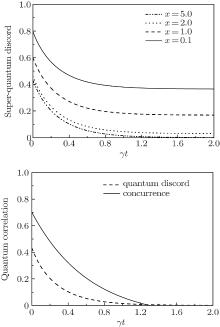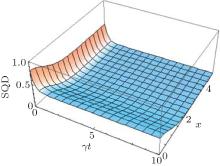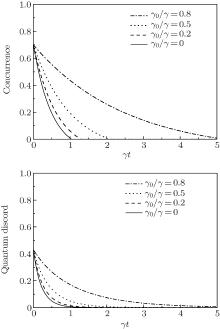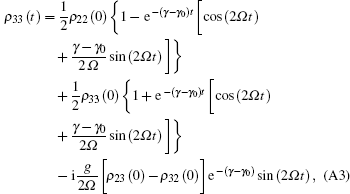†Corresponding author. E-mail: jyh2006@jxnu.edu.cn
*Project supported by the National Natural Science Foundation of China (Grant No. 11264015).
Super-quantum discord (SQD) with weak measurement is regarded as a kind of quantum correlation in quantum information processing. We compare and analyze the dynamical evolutions of SQD, quantum discord (QD), and quantum entanglement (QE) between two qubits in the correlated dephasing environmental model. The results indicate that (i) owing to the much smaller influence of weak measurement on the coherence of the system than that of von Neumann projection measurement, SQD with weak measurement is larger than QD, and (ii) dynamical evolution of QD or QE monotonically goes to zero with time, while SQD monotonically tends to a stable value and a freezing phenomenon occurs. The stable value after freezing mainly depends on the measurement strength and the purity of the initial quantum state.
With the development of quantum technologies, the research domain of control science has been extended to the micro-world, and quantum engineering is becoming an important theory.[1] State control and coherence preservation of quantum systems are essential in quantum engineering. The coherence and quantum correlation are in the domain of quantum information, and almost all quantum information processings are related to them. However, quantum measurement is essential for the process of quantum information processing. For a quantum system, the measurement instruments, similar to the dissipative environment, will result in coherence loss.[2, 3] This is exemplified by the fact that if we measure an arbitrary quantum state in some orthogonal basis, we lose its coherence because quantum states are fragile to quantum measurements. However, the system will be perturbed gently and may not lose its coherence completely if the measurement device couples to the system weakly.
Traditional quantum measurement technologies exploit von Neumann projection measurement to gain information. Undoubtedly, they might not be the optimal measurement schemes since these crude methods cause unrecoverable destructions to the quantum states as the information is acquired. In Ref. [4], a brand-new weak measurement was constructed. Although the gained information was less than the von Neumann projection measurement, the perturbation was much less. More significantly, the quantum states after weak measurement were recoverable. Pryde et al. managed to measure the polarization weak value of photons in a linear optical system.[5] Korotkov and Jordan proposed a scheme of weak measurement in superconducting qubits, [6] which was experimentally realized by Katz et al.[7] Recently, it was shown that weak measurements also help to protect quantum entanglement from the decoherence.[8– 15]
Searching for quantum correlation in a composite system and identifying its role in quantum information processing is one of the fundamental problems in quantum mechanics. Quantum entanglement (QE) is a kind of quantum correlation that has been playing a central role in quantum information and communication theory.[16] However, there are other nonclassical correlations apart from entanglement that can be of great importance for these fields.[17, 18] In order to characterize all nonclassical correlations, Ollivier and Zurek introduced quantum discord (QD); [19] it is a quantum correlation based on von Neumann measurement that can capture quantum correlation in separate states. It reveals the differences between quantum entanglement and quantum discord in characterizing quantum correlation. In addition to quantum entanglement and quantum discord, other quantum correlations are defined as well for the non-classical phenomena in different physical systems, such as measurement-induced disturbance (MID) and measurement-induced nonlocality (MIN).[20, 21] The former depicts the variation of mutual information before and after measurement, and the latter describes the effects of local invariant measurement on the ensemble state. Nowadays, however, the understanding of quantum correlation is still at the beginning stage, especially of the ones different from traditional quantum entanglement.[22]
As is well known, QD can accelerate the quantum computation compared with the system without quantum correlation. In many dissipative quantum systems, QD has stronger robustness than quantum entanglement. It will be beneficial to the exchange and transmission of quantum information, which is favorable to increasing the amplitude of quantum correlation, especially to maintaining the quantum correlation for quite a long period. Recently, it was shown that weak measurement performed on one of the subsystems can lead to “ super-quantum discord” (SQD) that is always larger than the QD captured by the strong (projective) measurements.[23] Existing research progress shows that SQD has vivid properties, such as the monotony, which gives a new insight into the nature of quantum correlation. Furthermore, SQD universally exists in quantum systems. Therefore, it is worth further exploration and is promising to open a new field in quantum information technology (e.g. detailed description of quantum correlation, detection, and transmission of quantum states, error correction of quantum information, etc.) since SQD is more conducive to maintaining even enhancing the quantum coherence and quantum correlation of the system. Their time evolutions, however, may not be completely the same due to different measurements and the complexity of open quantum system. And the view on SQD with the induction mechanism, measurement, and great potential application is still in its infancy. Weak measurement not only is important to explore the fundamental physical problems but also has technological implications. In this paper, we implement weak measurement on coupling qubits. Our purpose is to investigate the dynamical behaviors in an open system and compare the quantum correlations which are respectively measured by QE, QD, and SQD. We find that in a correlated dephasing environmental model, the dynamical behaviors of SQD really differ from those of QD or QE. The results show that a freezing phenomenon happens to SQD but not to QD.
To minimize the influence on the original quantum state, a measurement is introduced which induces a partial collapse of the quantum state. This is the so-called weak measurement. In Ref. [24], a weak measurement which just satisfies the following two conditions is constructed:


where | ± i〉 is the eigenstate of σ y. (i) If χ = π /2, two measurement operators are exactly the same and they are operators of 1/2 units. Thus, the measurement cannot obtain any results and the quantum state is completely unaffected. (ii) If χ = 0, two measurement operators degenerate to the form of von Neumann projection operator | ± i〉 . After measurement, the state of the qubit is projected to | + i〉 or | – i〉 . (iii) If 0 < χ < π /2, it is weak measurement. After weak measurement, the state of the qubit does not completely collapse into | + i〉 or | – i〉 , but still remains in a recoverable state.
QD for bipartite quantum state ρ AB with the strong measurement is defined as the difference in quantum version between two classically equivalent definitions of mutual information and can be given as[25]

with the minimization going over all projection-valued measurements {π k}, and the probability is given by pk = Tr[(I ⊗ π k)ρ AB (I ⊗ π k)]. S(ρ j) = − Tr(ρ j log2ρ j) is the von Neumann entropy of subsystem j, S(ρ AB) = − Tr(ρ AB log2ρ AB) denotes the von Neumann entropy of the total system. ρ A(ρ B) are the reduced density matrices of ρ AB. S(A| B) = S(ρ AB) − S(ρ B) is the conditional entropy.
The idea of weak measurement on the basis of quantum correlation is to replace all projection measurements with weak measurements, and to describe its classical correlation and quantum discord (known as super-quantum discord). SQD is defined as[26]

with



PB(± x) is the weak measurement operator performed on subsystem B, x is the measurement strength parameter,

If x → ∞ , weak measurement approximates to projection measurement.
In this paper, we evaluate the SQD for two-qubit Bell-diagonal state,

Corresponding to the density matrix and from Eq. (4), the SQD for ρ AB is given by[27]


with

Considering the coupling qubits (denoted as A and B) that are initially placed in the entangled state, the Hamiltonian is given by (ħ = 1)[28]

where 


In this paper, we mainly consider a correlated dephasing environmental model and investigate the effect of such an environment on quantum correlation dynamics of two qubits. Dephasing mode originates mainly from a coherent overlap between the upper and lower state wave functions and decays with time, but it does not affect the state populations. In addition, the calculation errors resulting from the leakage effect between multi-levels of superconducting qubit can be included in this dephasing mode. For the correlated dephasing decay mode, Lρ is expressed as

where the dephasing rates γ A and γ B are independent of each other in the case of noncorrelated environments, and γ 0 is the correlated dephasing rate which describes the correlation between the environments of two qubits. If γ 0 = 0, it turns into a purely dephasing decay mode.
The solutions of the quantum master equation depend on the initial state. We assume that the system is initially in the X-state and given as

We can see that the Bell state, the Werner state, and the maximally entangled mixed states under discussion in this paper all belong to the X-state. For a given initial state, the analytic solutions of master Eq. (13) with correlated dephasing mode are given in Appendix A.
In this section, the dynamical evolution of SQD is investigated and compared with those of QD and QE in order to characterizing its advantage of quantum correlation maintenance. We adopt the concurrence defined by Wootters[30] to measure the system QE. Under the X-state,

For simplicity, we only consider that two qubits are initially in the entangled mixed states:

where r varies from 0 to 1, and for r = 0 the Werner states become the maximally mixed states, while for r = 1 they are the well-known Bell states, and I4 is the 4 × 4 identity matrix.
From Eq. (10), we find that SQD is closely related to the measurement strength. In the following, therefore, we first discuss how the measurement strength affects the SQD, QD, and QE while the quantum system is initially in the ρ ψ (r, θ ).
From Fig. 1, for the measurement strength x = 5.0, the SQD may disappear during the dynamical evolution, i.e., the SQD death happens. With the strength increasing continuously, the survival time of SQD incessantly shortens. Obviously, when the strength x → ∞ , the weak measurement reduces to the strong measurement, the SQD approaches to the QD. We can also see that the QD and QE are not dependent on the measurement strength. From Figs. 1 and 2, we know that the strength influences not only the amplitude of the SQD but also its duration (namely, the survival time of nonzero for SQD).
 | Fig. 1. Time evolutions of SQD, QD, and QE for the correlated dephasing decay mode in ρ ψ (r, θ ) state with r = 0.8, g/γ = 2, and γ 0/γ = 0.2. |
 | Fig. 2. Effect of the measurement strength on SQD for the correlated dephasing decay mode in ρ ψ (r, θ ) state with r = 0.8, g/γ = 2, and γ 0/γ = 0.2. |
SQD can be handled directly by the measurement strength since the dynamical evolutions of SQD and its stable value are closely related to the measurement strength. Reference [31] proposed a scheme for weak measurement, which can be divided into three basic steps. i) Choose an auxiliary qubit that is in the ground state, and pass it through a rotation gate to prepare a proper state correlated with the parameter χ in Eqs. (1) and (2). ii) By using a control gate and rotation gate, the auxiliary qubit is entangled with the original signal. iii) Perform a standard von Neumann projection measurement on the auxiliary qubit so as to realize the weak measurement shown in Eq. (1) and Eq. (2) on the signal qubit. The strength of weak measurement can be controlled through adjusting the initial parameter χ of the auxiliary qubit.
In fact, the dynamical evolution of quantum correlation not only relates to the initial quantum state, but also depends on the dissipative mode of the environment. We will study the influence of the purity of initial quantum states, correlated dephasing rate and the coupling strength on the dynamical evolution of quantum correlation. Figures 3– 6 show the most representative evolution curves we choose. Really, because the influence of weak measurement on the coherence of the system correlation is much less than that of von Neumann projection measurement, it is obvious that weak measurements result in a small change of quantum states and the SQD being larger than the QD. Therefore, quantum weak measurement is a nice option for quantum information processing in the future and SQD is promising to be a novel and extremely important quantum information resource.
 | Fig. 3. Dynamic behaviors of SQD, QD, and QE as a function of γ t for the correlated dephasing decay mode in ρ ψ (r, θ ) state with x = 0.2, g/γ = 2, and γ 0/γ = 0.2. |
Figures 3 and 4 reflect the influences of the purity of the initial quantum state on SQD, QD, and QE. The influences of dissipation on their long-time evolutions are appreciably different. The decrease of the purity of initial quantum state makes the survival time of QD and QE shorter. QD or QE monotonically goes to zero with time, while SQD monotonically tends to a stable value and a freezing phenomenon occurs. The stable value after freezing depends on the purity of the initial quantum state r. The results show that the SQD always tends to a non-zero stable value by utilizing quantum weak measurement, which is very useful for quantum information processing.
 | Fig. 4. Dynamic behaviors of SQD and QE as a function of γ t for the correlated dephasing decay mode in ρ ψ (r, θ ) state with x = 1.0, g/γ = 2, and γ 0/γ = 0.2. |
Figure 3 also shows that in the correlated dephasing decay mode, the evolutions of QE and QD are similar to each other in ρ ψ (r, θ ) state. But the decay of QD with time is obviously slower than that of QE. So we can know that QD is more robust than QE.
Figures 5 and 6 present the influences of the correlated dephasing rate on SQD, QD, and QE. The correlated dephasing rate describes the correlation between the environments of two qubits, where a larger γ 0 implies a closer correlation between two qubits. The results show that the correlations are improved due to an obvious extension to the region of non-zero evolving time, which, therefore, is helpful to obtain the quantum information by using quantum correlations as a correlated measurement.
 | Fig. 5. SQDs in the correlated dephasing mode as a function of correlated dephasing rate γ 0 for the X-state ρ ψ (r, θ ) with r = 0.8 and g/γ = 2. |
As is well known, classical measurement presents no complications to the measured system. Quantum measurement, however, results in irreversible destruction which is negligible in the quantum field. Therefore, acquisition of information and disturbance to the quantum system has become a conflicted problem. In this paper, by investigating the dynamical behaviors of SQD with weak measurement in dissipative channels, we prove that although weak measurement obtains less information than von Neumann projection measurement, the disturbance on the quantum state is much smaller, which is good for the maintenance of quantum coherence and correlation. More significantly, the quantum coherence after weak measurement is recoverable. We also find that, in the correlated dephasing environmental model, QD or QE monotonically goes to zero with time going by, while SQD monotonically tends to a stable value and the freezing phenomenon occurs. Our results may be beneficial to deeply understanding the quantum weak measurement and quantum correlation, as well as the choice of quantum information resource.
| 1 |
|
| 2 |
|
| 3 |
|
| 4 |
|
| 5 |
|
| 6 |
|
| 7 |
|
| 8 |
|
| 9 |
|
| 10 |
|
| 11 |
|
| 12 |
|
| 13 |
|
| 14 |
|
| 15 |
|
| 16 |
|
| 17 |
|
| 18 |
|
| 19 |
|
| 20 |
|
| 21 |
|
| 22 |
|
| 23 |
|
| 24 |
|
| 25 |
|
| 26 |
|
| 27 |
|
| 28 |
|
| 29 |
|
| 30 |
|
| 31 |
|










